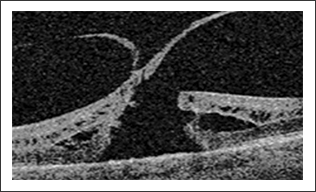A vitreo-macular traction is a condition in which the vitreous body pulls and moves the retinal surface. As the vitreous body degrades overtime, it moves away from the retina and pulls on the strong attachments between the retina and vitreous body. Due to the force of this pull, the retinal surface can curve outward and may even break under the strain. While there is the option of treatment through vitrectomy surgery, it is reserved for patients suffering serious vision loss.
WHAT IS THE DISEASE?
The degeneration of the vitreous body occurs naturally due to aging. Until the vitreous body is fully detached from the retina, this process puts stress on the connections between the retina and vitreous body causing the vitreo-retinal connections to pull on the retinal surface as the vitreous body breaks down. This can lead to structural damage to the retina, the formation of retinal cysts or bumps, and macular holes. Once the vitreous body has pulled free of the retina, however, there is typically a loss of symptoms and the restoration of lost vision.

An OCT image of a vitreo macular traction.

